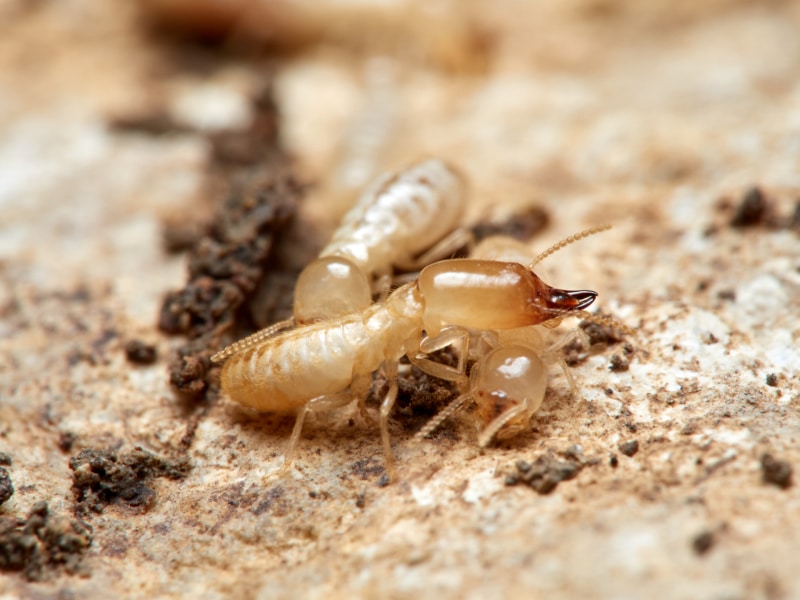
Nationwide, termites cause billions of dollars in damage to structures every year. If you live in the Lone Star state, you may wonder how much you need to worry about termites in Texas and, if so, what you can do to protect your home. In this post, we’ll provide the answers.
Are termites common in Texas?
Termites are common in Texas, although different species are more common in different parts of the state. Although characteristics differ among species, termites are insects that feed on the cellulose found in wood. These pests prefer hot weather conditions, so Texas’ hot summers and mild winters are ideal for them.
When do termites swarm in Texas?
Once every year, members of termite colonies called alates fly from their nests to reproduce. In Texas, this usually occurs in the spring when the weather begins to warm up. You’re most likely to see flying termites after it has rained.
What do termites look like in Texas?
Termites have six legs and a segmented body with a distinct head, thorax, and abdomen. They have two antennae and a pair of jaw-like appendages called mandibles on the fronts of their heads. Depending on the species, they may be brown, yellow, white, or black. Sizes also vary from species to species.
Types of termites in Texas
In Texas, there are three main termite species of concern: Eastern subterranean, western drywood, and Formosan subterranean. Let’s take a look at each of them.
Eastern subterranean termites
Also called the native subterranean termite, the eastern subterranean termite is the most common of the termites in Texas and is generally found throughout the state. These termites live below ground and are typically only spotted during swarming season.
Alates of the species are yellow-brown and usually around 0.4 inches long. You can identify them by the thickened veins present at the fronts of their bodies. Workers are pale white and less likely to be spotted because they remain in the colony.
Eastern subterranean termites prefer to feed on wood that’s in contact with the ground. They may infest lower stories of homes, wooden outbuildings, firewood piles, and other easily accessible lumber.

Western drywood termites
Unlike subterranean termites, western drywood termites live above ground and can get both the moisture and nourishment they need to survive from the wood they consume. You can find Western drywood termites in Texas throughout the state, but they are most common in the Gulf Coast region.
Western drywood termite swarmers are roughly the same size as eastern subterranean termites but are light yellow with colorless wings. They tend to swarm in the dark rather than during the day, so if you see flying termites in Texas at night, the drywood species is likely present.

Formosan subterranean termites
Formosan subterranean termites are less common in Texas and generally found only in the Gulf Coast region. The species originated in Taiwan and China but has begun to be more prevalent in the Southwest in recent years. Like Eastern subterranean termites, they live underground. However, they can also establish secondary aerial nests in the structures that they infest.
Compared to other subterranean termites, Formosan termites reproduce incredibly fast. Within five years, a single colony can include 1 million Formosan termites. Due to the size of their colonies, the pests are extremely destructive.
Reproductive Formosan termites are slightly larger than Eastern subterranean termites at around 0.5 to 0.6 inches in length. Their color and markings are similar to the Eastern subterranean termites, but the species has tiny hairs on their wings. They often swarm at night, but their mating season occurs in the early summer rather than the spring.

Signs of termites in Texas
During swarming season, you may see termites flying around an infested area in Texas. After the season ends, small wings that resemble tiny flower petals may be scattered around. You can also spot termites in Texas from the damage they cause. Warning signs include:
- Drywall discoloration
- Drooping drywall
- Peeling paint
- Loose tiles
- Tiny pinhead-sized holes in wood
- Squeaky floorboards
- Crumbling wood
- Small piles of pellets that look like salt and pepper, if drywood termites are in the area
- Pencil-sized tubes of mud running along the ground if subterranean termites are present
How to get rid of termites in Texas
The best way to get rid of termites is to hire a professional pest control company. Licensed pest control technicians can conduct a termite inspection and develop a treatment plan to address infestations. Calling professionals as soon as you notice signs of an infestation is the best way to limit the damage that termites cause.
Pest control services
If you have an infestation of termites, Hawx Pest Control can help. Our licensed technicians have state-of-the-art tools and technologies to target termite colonies. In addition, our technicians can identify risk factors for termite infestations, such as areas of water damage, so that you can take steps to address problems and lower the likelihood of the pests returning in the future.
RELATED POSTS


